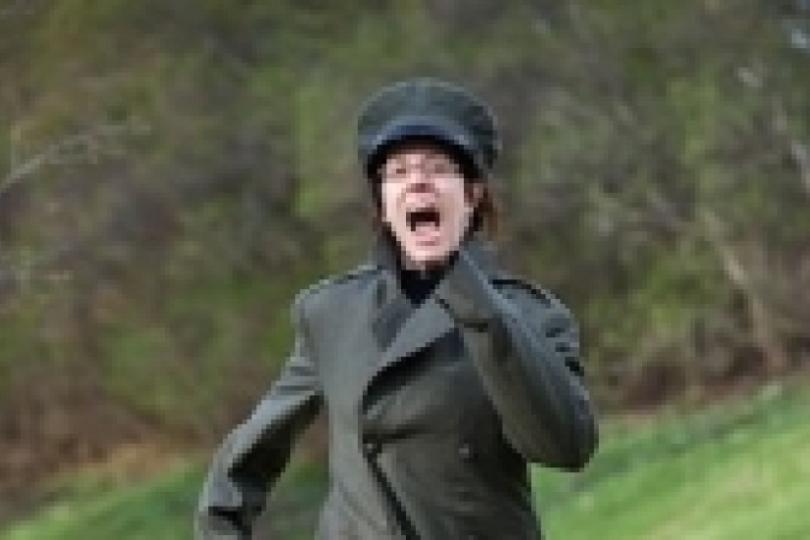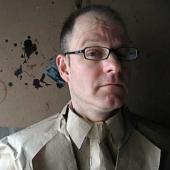Dialogue, Part 3: What should art do?
Editorial

One danger of rational discourse is that it builds walls around what it is possible to think. My goal here is to open up the doors around the eminently rational notion of creative placemaking with the following citations and thoughts:
When Skewed Visions selected the Minneapolis Farmers Market for its site-specific installation performance The Eye in the Door, Part Two: Breakfast of Champions, the group anticipated the usual obstacles that accompany outdoor events. As it turns out, bad weather and distracted crowds were the least of its troubles. After appearing the first two Sundays of this month, the company discovered that some market-goers were disturbed by the performance and that management would not allow the show to continue without changes in content. So notified, Skewed Visions, a performance troupe that formed last year, found itself in the position of deciding whether to alter its piece or close up shop and go someplace more welcoming.
Complicating matters was the fact that the piece takes place in the Annex, a privately owned portion of the otherwise city-run Farmers Market. This left little room for Skewed Visions to charge censorship or argue for a right to express its views in public, a position undermined by a recent court decision that upheld the Mall of America's right to restrict protesters. For Skewed Visions, however, the issue has provided a chance to explore the clash of values existing between art and, in this case, a literal marketplace. "We felt we were going to the roots of theatricality, and its emphasis on commerce and exchanging ideas," says director Gülgün Kayim. "It turns out there's only freedom of speech until you start making money."
-- Anne Ursu, Naked Lunch. City Pages
* * *
Successful creative placemaking…
…is always presenting itself to the public and encouraging pedestrian activity. Whether open or closed, a place that is a consistently interesting and active presence to the street promotes more pedestrian activity and creates the public perception that the place is safer and more animated. More pedestrians mean more prospective customers on the street to support more small businesses.
…creates a place where business wants to be. As a place becomes more active, commerce is likely to respond, thus giving people even more reasons to be there.
-- Principles of Creative Placemaking, Artplace.org
* * *
If we are asking artists to be our urban planners, community developers and marketing force, what do we owe artists in return? The basic premise of creative placemaking is that concentrated arts activity creates value for a community, which can be manifested as job creation, complementary development, housing values, or other outcomes.
While those are powerful outcomes, it begs the question (most clearly framed by Tim Jones): “If we are using artists to create value for a community, how do we ensure that artists capture a slice of the pie?” In fact, while artists are good at many things, they are clearly challenged when it comes to benefitting in a sustained way from the community improvements they make. A well-known irony of arts-driven community transformation is that artists are frequently victims of their own success – creating desirable places where they can no longer afford to remain. And as artists decamp, they often drain the community of the vitality that made it dynamic in the first place.
No one in the field wants to exploit artists by simply using them on the cheap to create value for others. Most of us assume that if artists engage in this public work, they are also creating visibility and audience for themselves, which should translate into opportunity to earn from their artistic work. But if we are serious about compensating artists for the services they provide, shouldn’t the field’s emerging indicator systems focus not just on benefits to the general community, but specifically on questions like, “Are artists more capable of producing their work? Are they able to earn more from their artistic endeavors?”
-- Kelley Lindquist, Creative Placemaking: The ArtSpace Approach, February 26, 2013
* * *
. . . Art as much as anything else is part of the capitalist forces, either on the level of expression and representation or in respect of subsidies, grants, circulation and distribution. We are fucked no matter what, so now what do we do? There’s no independent art and has never been, and that is obviously art’s and our lucky day. There can be more or less independent art but it’s always and thoroughly inscribed in political economy, doesn’t matter if it’s some rich guy, the art council, the church, trust funds, institutional something – there is no outside.
-- Mårten Spångberg. Set It On Fuckin’ Fire, August 7, 2014
* * *
I think Charles thinks that there are forces at work channeling the critical use of imagination and the creative impulse into more socially and economically “productive” avenues. Successfully turning potentially disruptive agents into anodyne automatons who help deflect dissatisfaction and maintain the social order. Also, I think he thinks that people have a hard time complaining because:
* * *
Bring artists in. Give them the power. But isn’t that really more about using artists to save the infrastructure and capital of a city — a decaying pile of asphalt, steel, and cement where a bunch of people struggle to stay alive and forget about dying?
The arts are only an economic engine when they are part of an economic vehicle.
We are hit in the face so many times per day with sledgehammers weighing so many pounds that when someone taps us on the bridge of the nose with a monkey wrench we call it pleasure and lick their shoes. Artists will always go where the money is because they have to. How far they go and for what price is up to their individual integrity and stamina.
Maybe this writes Art out of the equation entirely, absorbing it into a hyper-capitalist economy by re-categorizing it as a socially productive skill produced by trained workers who can’t otherwise be absorbed by the Hollywood and Gaming industries, where the real artists make real money on real art for real people.
--Charles Campbell, Why Creative Placemaking, blog, July 12, 2012
* * *
To make a piece of thoughtful entertainment for the community that will appreciate it, while maybe acceptable by those who request rationalizations, is a miserable betrayal of the actual ACTION of ART.
Saving the world? Leave that attempt to the Saviors. Changing minds? Leave that to the Proselytizers. Educating the ignorant? Leave that to the Teachers. I am not that big, not that strong, not that brave, and not that arrogant.
To fail at making work that will allow us to, for a moment, NOT DIE is both daring enough and humble enough. Daring enough because it is impossible. This is finally something worth doing in the face of all that we face. For this I will put up with the daily sledgehammer in the face. And humble enough because it is impossible. It is a useless task little recognized, less valued, and I can go about it without fear. Because it will inevitably fail.
In the face of inevitable failure, why settle for anything less than the impossible?
--Charles Campbell, What is this? Where are we now? This place. This thing…this., November 20, 2013
* * *
Affluence creates poverty.
-- Marshall McLuhan.
* * *
. . . It could be said that hegemony brings domination to an end. We, emancipated workers, internalize the Global Order and its operational setup of which we are the hostages far more than the slaves. Consensus, be it voluntary or involuntary, replaces traditional servitude, which still belongs to the symbolic register of domination.
-- Jean Baudrillard. The Agony of Power, p 33-34
* * *
Caught up in one of those nightmares in which the dreamer loses his way, has no idea how to find the path home, and instead of drawing ever closer, strays even farther from the place in the city where he loves, roams about amid forbidding landscapes, fords raging streams and rivers, scales steep slopes and mountainsides, his abode ever more distant, so you wander farther and farther afield from the book, from the urgent task of compiling the material at hand and making of it a conventional novel, a presentable, well-made market product. You have climbed snow-covered peaks, covered with birches and firs, and from this vantage point you observe, helplessly, the besieged city far below.
Have you perhaps taken advantage of the opening of a ‘tourist route,’ ironically suggested to you by a member of the polyglot circle thoroughly familiar with Swift’s works, a route whereby those fond of powerful sensations would be able to journey without risk to the mountain heights that surround the rattrap and there enjoy the thrilling spectacle of its bombardment, with the right to participate in it if such were their inclination or desire?
-- Juan Goytisolo, State of Siege, p134
- These placating activities aren’t handed down from on high, but are promoted as grassroots, community-building experiences – dispersing any criticism away from authority to a generalized population, and
- Because funding for artists is increasingly restricted to this kind of activity, making these activities attractive regardless of their politics or efficacy, and
- Because these activities often originate from artists themselves, whose practices often align with the means that authorities co-opt for social control.




